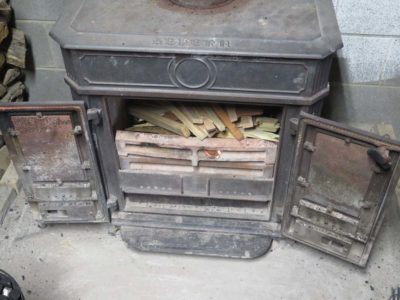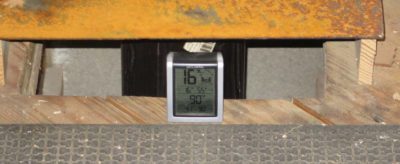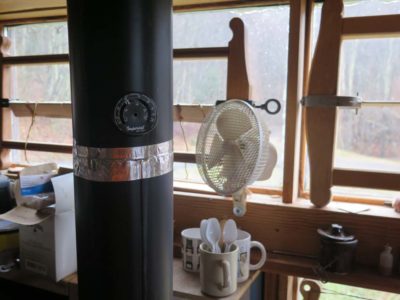The Every-Other-Morning Winter Ritual
My morning routine over the winter involves a light bit of attention to the wood/coal stove one morning and a more in-depth regimen the second day. Here is how my day usually begins for the heavy heating season from about the beginning of December through mid-March. I guess I could just rely on the propane wall furnace, but since propane is the very highest expense method I am disinclined to go that route. I’m guessing that would be somewhere north of $750/month even though my workshop is super-insulated (R43 XPS panels). I longingly note the falling prices of gasoline and the simultaneous rise of propane prices, the last fill-up was almost $4/gallon. So instead I rely on my triple combination of wood, coal, and kerosene.


On half of the mornings I arrive to a half-clean firebox with a few glowing coals, keeping the space between 45-40 degrees requiring only a couple minutes of cleaning out some of the clinkers. All I have to do is fire it up again and it is ready to work all day and through the night.
On that second day, however, the residual pile of clinkers requires a pretty thorough cleaning of the firebox. I must say I am pretty disappointed at the mound of clinkers remaining after the fire, I’ve been buying what I thought was good quality anthracite but as you will see there is always a full bucket of clinkers to get rid of. If I had cleaner burning coal my clean out would take two minutes a day.

This is what the fire box looks like after two days of burning. The clinkers fill the bottom from the bottom horizontal grate, slightly below the bottom of the opening, up to the top of the removable fence grates in the front.

The front fence grates slide up and out, giving me full access to the bottom grate so I can shovel out the clinkers. (The ash falls down into the ash box below.)

It is now time to lay the foundation for the new fire to come. I put the bottom fence grate in place and fill the space behind it with coal to a depth of 2-3 inches.

It is now time to turn my attention to the ash box, which slides out like a drawer. Its contents join the clinkers in the ash bucket.

Unfortunately the ash box goes into a space that is larger than it is, so the areas outside the ash box need to be cleaned out too.

Once everything is cleaned out and swept the whole assembly goes back together.

On top of the bed of coal I place a paper towel left over from its use as a wax filter, then pile kindling on top of that. I leave a little tail of the firestarter poling through the front fence to give me an easy place to light the fire. Which I do.

Before long I have crackling flames. This usually takes a minute or so.

After about three minutes I set the stove doors for maximum bast furnace effect.

About 5-7 minutes later the chimney is hot as a pistol. This is not the heat level I maintain, I normally operate the stove near the bottom of the operating range. I can now leave the stove on its own for an hour or so, then add another piece or two of firewood and another couple scoops of coal.

Meanwhile, upstairs at the floor level of the shop, I have created a heat stack vent by raising the chimney collar. This allows the hot air from both the stove and the chimney to more easily enter the shop.

Usually about the time I get back upstairs the stack is providing hot air for the space.

I augment this with a small fan blowing on the chimney to distribute even more heat into the space. I used to have a heat exchanger in-line in the chimney but have it currently removed because it requires constant power and in the winter I often power down my entire system at the end of the day.
I add additional scoops of coal a couple times throughout the day, but mostly I just get on with my day, loading it one final time when I close up for the evening.
I cannot pretend I am completely satisfied with this system. We are looking into upgrading the heat source for the cabin, and I just might do so for the barn too. I’m thinking about a Kimberly gasifier stove but am still gathering information.


Hi Mr. Williams,
I really like reading your blog. Thanks for posting, it’s always a pleasure to read and you are obviously very talented.
I am a licensed fire protection engineer – after reading your blog about lifting your chimney collar, I’m a little concerned for your safety and the safety of your belongings. If you have created an unobstructed opening between your two floors and there is an issue with your coal stove, there will be nothing to prevent the hot gasses and effects of fire from traveling directly up and into your workshop. Maybe not an issue, but I wouldn’t feel right not dropping you a line about that.
Hi Mike
Thanks for your kind words and concern. I will noodle the issue. I cannot see any way around using floor grates or something similar to get the heat from the first floor to the shop above it.
Don have you given any thoughts to a thermal fan? Garrett Wade sells two models and neither uses electricity but the heat from the stove to spin the fan.
Low CFM model part # is 25T05.01
We’ve got one of them on the wood stove in the cabin. Complete waste of money IMHO.
Hoping you are on the road to recovery.